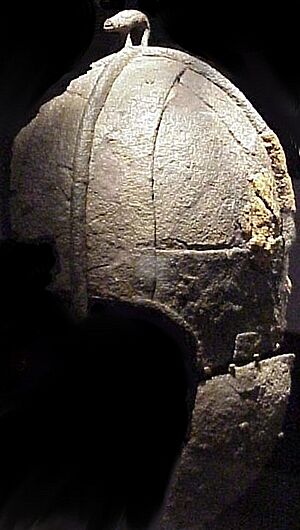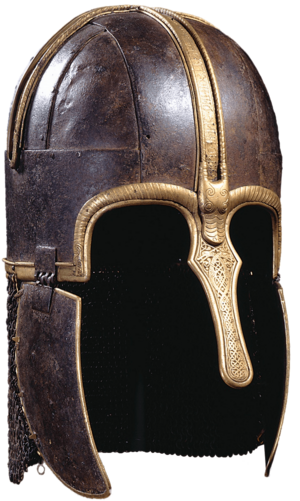Pioneer Helmet facts for kids
Quick facts for kids Pioneer Helmet |
|
|---|---|

The Pioneer Helmet
|
|
| Material | Iron |
| Created | 7th century |
| Discovered | 1997 Wollaston, Northamptonshire, United Kingdom 52°15′20″N 0°42′14″W / 52.25553°N 0.70387°W |
| Discovered by | Ian Meadows |
| Present location | Royal Armouries Museum, Leeds |
The Pioneer Helmet is a very old helmet from the late 600s. It was made by the Anglo-Saxons, who lived in England a long time ago. This special helmet has a boar (a type of wild pig) on top! It was found in 1997 in a place called Wollaston, Northamptonshire, in the United Kingdom.
This helmet was part of a young warrior's grave. Other cool items found with it, like a fancy bowl and a special sword, show that the person buried was very important.
The Pioneer Helmet might look simple, but it's super rare! Only six Anglo-Saxon helmets have ever been found. It's similar to the famous Coppergate Helmet found in York. These helmets are called "crested helmets" and were popular in England and Scandinavia for hundreds of years.
The boar on top of the helmet was very important. For Anglo-Saxons, the boar was a symbol of protection from the gods. The Pioneer Helmet is one of only three helmets known to still have its boar crest. Ancient poems, like Beowulf, even mention helmets with boar decorations. This shows how important these symbols were to warriors long ago.
The helmet was named after Pioneer Aggregates UK Ltd, the company that helped pay for its discovery and care. It was first shown in Leicester. Today, you can see the Pioneer Helmet at the Royal Armouries Museum in Leeds.
What the Pioneer Helmet Looks Like

The Pioneer Helmet looks a lot like the Coppergate Helmet. But it's simpler and doesn't have much decoration. It might have been made a bit bigger to fit extra padding inside.
The helmet was made from 12 separate pieces of iron, all joined together with small metal pins called rivets. It had a main cap for the head and two pieces that hung down to protect the cheeks. We don't know for sure how the neck was protected, because that part of the helmet was damaged over time.
The cap was built with four main pieces. These formed a band around the forehead and a strip from the nose to the back of the neck. Other pieces filled in the gaps. There were cutouts for the eyes. A thin strip of metal was added around these openings.
The boar on top was made from a single iron rod. It was shaped to look like a boar, with legs and a snout. The boar wasn't decorated much, just simple shapes to show its features.
Two cheek guards hung from the helmet. Only one of these, the left one, is mostly left. It was curved to fit the face. Metal strips and rivets held the cheek guards to the main helmet cap. There was also a rivet in the middle of the cheek guard. This was probably for attaching leather straps to tighten the helmet.
How the Helmet Was Found
The Pioneer Helmet was found in March 1997. It was discovered during an excavation in Wollaston, near Wellingborough. This area was being dug up for gravel. For years, archaeologists had been finding old farms from the Iron Age and Roman times there.
One day, a metal detector found a copper alloy bowl. This bowl was part of a grave. An archaeologist named Ian Meadows quickly recognized how important it was and started digging carefully.
The grave was a long oval shape, about 2.8 meters (9 feet) long. It was only 15 centimeters (6 inches) deep because farming had flattened the land over many years. This meant some items, like a shield or spears, might have been lost.
Archaeologists used brushes and wooden tools to dig up the grave. They found bone pieces, including part of a skull. These showed the person buried was a young man, about 17 to 25 years old. He was lying on his back with his head on a pillow.
Other items found in the grave included iron buckles, a small knife, a hook, and a special sword. These items, along with the fancy bowl and the helmet, showed that the buried person was very important in his community.
The helmet was found near where the man's left hip would have been. It was lying on its side. Before it was buried, the nose guard part of the helmet was bent inwards. This might have been a "ritual killing" of the object. Some ancient cultures, like the Anglo-Saxons and Vikings, would deliberately break objects before burial. This could have been to release the object's spirit or to stop grave robbers.
When the helmet was first found, it looked like a bucket! Archaeologists carefully covered it in plastic wrap and plaster bandages. Then they took it to a lab in Leicester. There, experts used X-rays to see the boar-crested helmet inside the soil block.
The helmet was broken into many pieces, sometimes 100 to 200 fragments. These pieces were carefully put back together using special glue. The surviving cheek guard alone was made from 18 tiny pieces!
After being cleaned and studied with digital X-rays and CT scans, the helmet was put back together. Missing parts were filled in and painted. Finally, the boar was attached to the top. News about this amazing discovery spread all over the world. The helmet was first shown to the public on December 23, 1997.
The land where the helmet was found belonged to Peter Gammidge and John Minney. The helmet is now owned by Mr. Gammidge and Mr. Minney's family. It was named the "Pioneer Helmet" because Pioneer Aggregates UK Ltd helped pay for its care. You can see it today at the Royal Armouries Museum in Leeds.
Types of Helmets
The Pioneer Helmet is from the late 600s. This date is based on the style of belt buckles found in the grave. It is one of only six Anglo-Saxon helmets ever found. The others were found at Benty Grange, Sutton Hoo, York, Shorwell, and Staffordshire.
The Pioneer Helmet, like most of these, is a "crested helmet." These helmets have a rounded top and often a clear crest running from the nose to the back of the neck. Crested helmets were common in Northern Europe from the 500s to the 1000s AD.

